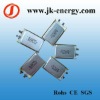- Contact Person : Ms. Qiu Jully
- Company Name : Shenzhen Jinke Energy Development Co., Ltd.
- Tel : 86-755-36896686
- Fax : 86-755-29736260
- Address : Guangdong,Shenzhen,NO.9-10 Building,Junxin Industrial Zone,Guanlan Street,Bao'an District,Shenzhen City
- Country/Region : China
- Zip : 518100
Related Product Searches:Lithium ion polymer battery cell 603075,High Quality 3.7v li polymer battery,3.7v li polymer battery 603075
PRODUCT SPECIFICATION
Lithium polymer battery in our factory:
100% safe
long lifespan
Well performace
High discharge rate capability
Low self-discharge
Battery Quality
1. Cells: A grade cells to make sure batteries in high and full capacity
2.Protection: Dual IC chips,that can anti-shortcircuit, anti-overcharger, anti-overcurrent, anti-overload
3.Compose Type : Injection Technology to make battery more stable
4.Certifications : CE,RoHS,UL,ISO9001
5. Long life cycly, No memory, environment friendly
Advantages:
1, High energy density
2, High working voltage for single battery cells
3, Pollution-free
4, Long cycle life
5, No memory effect
6, Capacity, resistance, Voltage, platform time consistency is good
7, Safe and reliable
8, Factory price& High quality
Features:
1, Longer storage life than NiMH Batteries
2, Light weight and higher energy density than any rechargeable battery
3, Installed IC chip will prevent the battery pack from over charge and over discharge.
It helps protect battery chemistry integrity and prolongs battery life.
2.Characteristics
2.1 Electro chemical performance characteristics
No. | content | Testing method | Requirements |
1 | Charge cut-off voltage | 4.20±0.05V | |
2 | Discharge cut-off voltage | 3.00±0.05V | |
3 | Standard charge | 1. Charge the battery at constant current of 0.2C to reach 4.2V. Then charge the battery at constant 4.2V voltage until the charging current decreasing to 0.01C. 2. Charge the battery at constant current of 0.5C to reach 4.2V. Then charge the battery at constant 4.2V voltage until the charging current decreasing to 0.01C. | Charge time≤8 hours |
4 | Standard discharge | After the standard charging,rest for 1 hour then discharge to 3.0V @ 0.2C. | Discharging time≥300Min |
5 | Rate discharge | After the standard charging,rest for 1 hour then discharge to 3.0V@1C. | Discharging time≥51Min |
6 | High temperature characteristics | Fully charging, store them at (55±2)°C for 2 hours, then discharge to 3.0V @1C. | Discharging time≥51Min No transform No explosion,No fire,No leakage. |
7 | Low temperature Characteristics | Full charging, store them at (-10±2)°C for 16-24 hours, then discharge to 3.0V @0.2C. | Discharging time≥210 Min No transform , No explosion, No fire,No leakage. |
8 | Capacity retention | Fully charging, store them at (20±2)°C for 28 days, then discharge to 3.0V @0.2C. | Discharging time≥255Min |
9 | Cycle Life @25°C | .Discharge to 3.0V @0.5C, then Charge the battery @0.5C to reach 4.2V. Then charge the battery at constant 4.2V voltage until the charging current decreasing to 0.01C. Rest for 10 min. discharge to 3.0V@ 0.5C and rest for 10 min. Continue the charge/discharge cycles until discharge capacity lower than 80% of rated capacity. | Cycle life ≥300 |
10 | Storage | Charge the battery to 40%- 65% of its rated capacity using standard charging mode, then keep it in an 20°C±5°C, humidity 45%- 85% room for 12 months. Discharge it @0.2C until voltage down to 3.0V. (The testing sample should be within 3 months dated from production date) | Discharge time≥240Min |








